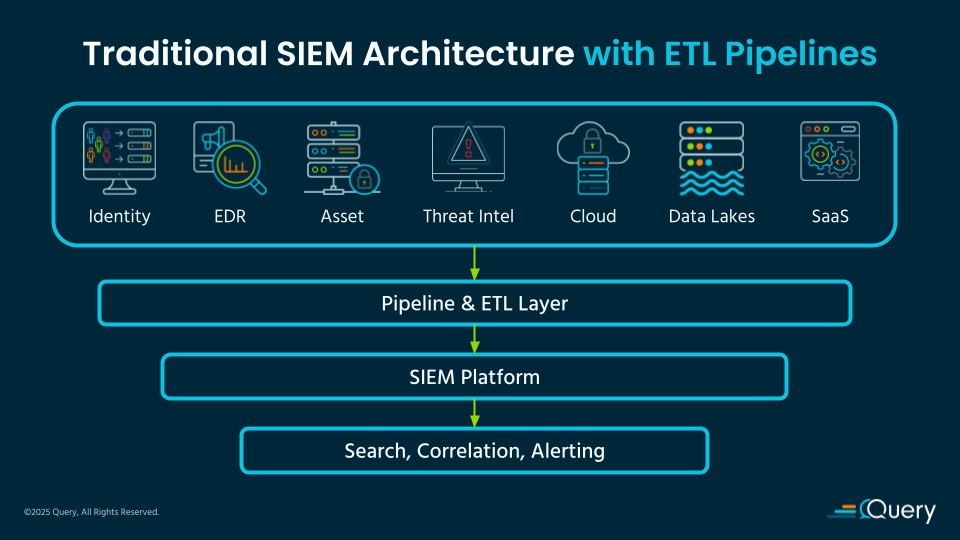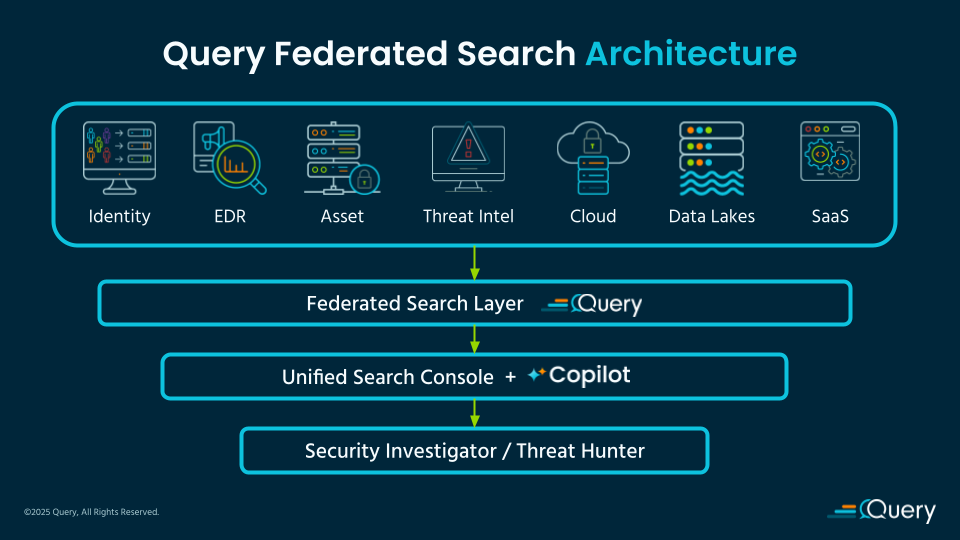Security operations has always been a data problem. The challenge today isn’t a lack of data—it’s that the data you need is spread across too many systems, locked behind too many interfaces, and too hard to use when it matters. Traditional SIEM architectures were designed in a different era, and they haven’t kept up.
Most enterprise security teams are wrestling with high storage costs, brittle data pipelines, and limited visibility. Centralizing all your data in a single system is expensive, slow, and often incomplete. You’re left making critical decisions without the full picture.
Query Federated Search offers a different approach. Instead of forcing data into one place, Query lets you search data where it lives—whether that’s a cloud API, a SaaS platform, or a data lake.
The Traditional SIEM Model: Centralize First, Analyze Later
The default architecture for years has been “ingest everything into the SIEM.” That means collecting, normalizing, storing, and paying for data—before you can even use it.
The problems are well-known:
- Runaway costs – Ingesting petabytes of data into a SIEM is financially unsustainable.
- Long onboarding times – Adding a new data source can take weeks or months.
- Visibility gaps – Many important data sources are never ingested due to cost or ownership.
- Tool fatigue – Analysts constantly pivot between tabs, tools, and syntaxes.
The Rise of ETL and Security Data Pipelines
To manage the cost and complexity of SIEMs, many teams are adopting data pipeline tools like Cribl or building custom ETL layers. These solutions offer more control, but they also add complexity:
- More infrastructure to manage
- More time spent building and maintaining pipelines
- More risk if a transform breaks or misses key data
Example: One Fortune 500 org was paying over $7M/year for a cloud SIEM. They still couldn’t get real-time access to AWS GuardDuty, Okta admin logs, or Salesforce events. Even with a pipeline in place, new data sources took weeks to onboard.

The Query Federated Approach
Query eliminates the need for upfront ingestion, complex ETL, or duplicate storage. Instead, it connects directly to your tools and systems using read-only APIs and federates searches across them.
What Makes It Different:
- No Centralization Required
Leave data where it lives. Query integrates with Amazon Security Lake, Okta, CrowdStrike, Splunk, ServiceNow, and dozens more. - Search Once, See Everything
One query spans all connected data sources. Results are normalized (to OCSF), enriched with context, and returned in one place. - Onboard in Minutes, Not Months
Connect a new source in minutes—no custom parsers, pipeline logic, or onboarding projects.
Built for How Security Teams Work
Analysts, hunters, and responders get a console built for answering security questions fast. Query Copilot summarizes, correlates, and accelerates workflows.

Real-World Example: Faster Threat Hunts, Fewer Pivots
You’re investigating lateral movement with stolen credentials. In the SIEM model, that’s:
- Detection in SIEM → Pivot to Okta → Pivot to AWS → Pivot to EDR → Pivot to asset inventory.
- Each tool has a different query language, login, and data format.
- Manual stitching of results in spreadsheets or docs.
With Query:
- One federated search spans Okta, AWS, CrowdStrike, ServiceNow.
- Results are unified and enriched.
- Query Copilot helps summarize, extract IOCs and recommend next steps.
Why It Matters
Federated Search doesn’t just make things faster. It changes the model entirely:
- Lower TCO – No paying twice to store the same data.
- Faster time to value – No waiting weeks to onboard new data.
- Better use of what you already have – Data in cloud and business systems is no longer out of reach.
- No lock-in – Your data, your architecture, your choice.
The Future Is Federated
SIEMs still have a place—for detections and alerting. But investigations, threat hunts, and data exploration require a model built for distributed, fast-moving environments.
Query Federated Search complements your SIEM. It eliminates the pain between alert and answer.
If you’re ready to stop wrangling pipelines and start getting answers, it’s time to rethink your architecture. Federated Search is already unlocking value for enterprise teams—and it’s only getting more powerful from here.

